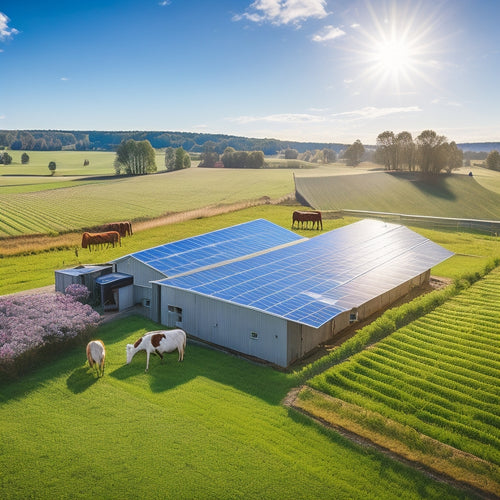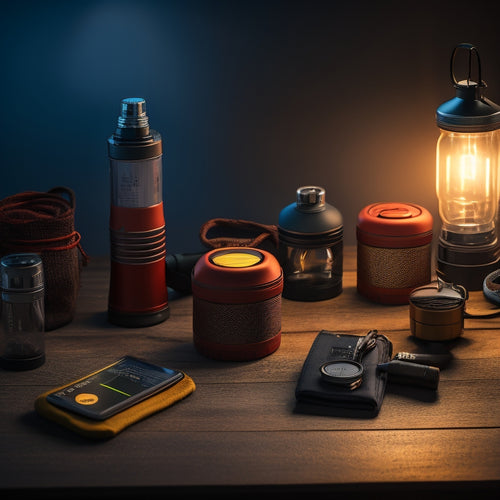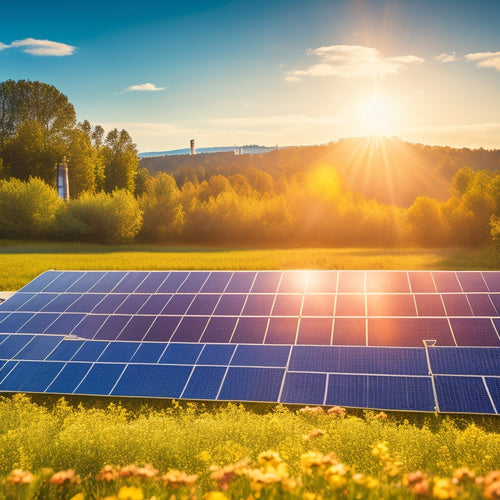
Commercial Solar Installation
Share
You're considering a commercial solar installation to harness the power of renewable energy and reduce your business's reliance on non-renewable sources. With government incentives like federal tax credits and state rebate programs, you can greatly lower installation costs. By going solar, you'll achieve a zero-carbon footprint, reduce energy dependence, and lower energy costs in the long run. Advanced inverter technologies and high-power density designs enable maximum energy collection, while energy storage options guarantee a consistent power supply. Evaluating your energy demands and optimizing energy conversion rates are essential for a successful installation. Now, you're just a step away from revealing the full potential of commercial solar installation.
The Essentials
- Commercial solar installations can reduce energy costs and achieve a zero-carbon footprint with government incentives and renewable energy solutions.
- Federal tax credits provide a 30% deduction on total solar installation costs, with additional state rebate programs available to reduce expenses further.
- Advanced inverter technology and high power density enable maximum energy collection, with bifacial solar panels potentially boosting output by up to 25%.
- Assessing energy demands and usage patterns is crucial for optimal solar installation, including analyzing consumption trends and peak usage times.
- Regular maintenance prevents energy losses from soiling, shading, or failures, ensuring a higher energy conversion rate and maximizing energy output.
Government Incentives Boost Savings
You'll be pleased to know that the government offers several incentives to help offset the cost of commercial solar installation.
Many businesses are already utilizing Renewable Energy Systems to reduce their carbon footprint and promote eco-friendliness.
Specifically, you can claim a considerable portion of your installation costs as a credit on your federal taxes, and many states offer additional rebate programs to further reduce your expenses.
Federal Tax Credits
As the solar industry continues to evolve, one major advantage of commercial solar installation remains the federal tax credits, which greatly boost the savings for businesses. You can take advantage of these credits to offset a considerable portion of your solar installation costs.
By opting for a professional Renewable Energy Solutions, you can guarantee a safe and secure installation process that comes with a warranty and ongoing maintenance support. To qualify for tax credit eligibility, your business must have a tax liability to offset the credit.
The federal government offers a 30% tax credit of the total solar installation cost, allowing you to claim this credit on your business's tax return. This incentive can greatly reduce your upfront costs and accelerate your return on investment.
You can also investigate funding options that allow you to monetize the tax credit, providing additional financial flexibility. By leveraging federal tax credits, you can maximize your savings and achieve a faster payback period on your commercial solar installation investment.
State Rebate Programs
Beyond federal tax credits, government incentives at the state level can further enhance the financial benefits of commercial solar installation. As you investigate state rebate programs, you'll find that each state has its own unique set of incentives and eligibility criteria.
Many small businesses are turning to renewable energy solutions to reduce their energy expenses and establish a more sustainable business model. By leveraging these incentives, businesses can overcome the obstacles of rising energy costs and unpredictable energy bills, and instead drive growth, profitability, and long-term success.
To take advantage of these rebates, you'll need to verify your business meets the state's eligibility criteria, which may include factors such as system size, installation date, and energy efficiency standards.
Once you've determined your eligibility, you'll need to traverse the rebate application process. This typically involves submitting an application, providing documentation of your solar installation, and waiting for approval.
The rebate amount and application process vary by state, so it's crucial to research the specific requirements and deadlines for your state. By leveraging state rebate programs, you can greatly reduce the upfront cost of your commercial solar installation, making it an even more attractive investment for your business.
Zero Carbon Footprint
By installing a commercial solar system, you're taking a considerable step towards reducing your energy dependence on non-renewable sources.
This shift enables you to utilize renewable energy solutions, which include solar panels, inverters, and photovoltaic systems, and considerably decreasing your reliance on the grid.
As a result, you'll be well on your way to achieving a zero-carbon footprint, minimizing your environmental impact while also cutting energy costs.
Reducing Energy Dependence
With the increasing awareness of climate change, reducing energy dependence has become a top priority for many organizations and individuals. You're likely considering commercial solar installation to achieve energy independence, and rightly so. By reducing your reliance on the grid, you can enjoy sustainable practices and a significant decrease in your carbon footprint.
Here's a breakdown of the benefits of reducing energy dependence:
| Benefits | Description |
|---|---|
| Energy Independence | Generate your own power and reduce reliance on the grid |
| Cost Savings | Lower your energy bills and enjoy long-term savings |
| Environmental Impact | Contribute to a cleaner environment by reducing greenhouse gas emissions |
Renewable Energy Solutions
You're taking a significant step towards achieving a zero-carbon footprint by exploring renewable energy solutions. As a commercial entity, shifting to clean energy not only benefits the environment but also enhances your brand reputation and reduces energy costs.
When it comes to solar panel types, you have various options to choose from, including monocrystalline, polycrystalline, and thin-film panels. Each type has its unique characteristics, such as efficiency rates and durability, which should be considered based on your energy requirements and installation constraints.
Energy storage is another vital aspect of renewable energy solutions. You can opt for battery storage systems, such as lithium-ion or lead-acid batteries, to store excess energy generated by your solar panels during the day.
This stored energy can be employed during periods of low sunlight or at night, ensuring a consistent power supply. By integrating energy storage with your solar installation, you can maximize your energy independence and reduce reliance on the grid.
Maximum Efficiency Inverter Technology
You're looking for inverters that maximize energy harvest in your commercial solar installation.
High power density inverters are a key component in achieving this goal, as they enable more efficient energy conversion in a smaller footprint.
Incorporating solar trackers and advanced mounting systems can also help optimize energy production.
Additionally, advanced cooling systems, such as dual-stage cooling or liquid cooling, help to reduce thermal losses and further optimize inverter performance.
High Power Density
Your commercial solar installation's inverter technology plays an essential role in maximizing energy collection, and high power density inverters are the key to achieving maximum efficiency.
These inverters are designed to handle high power outputs while maintaining a compact footprint, making them ideal for commercial solar installations where space is limited. By increasing the power density, you can generate more energy from the same surface area, reducing the overall cost of your solar panel installation.
High power density inverters are made possible by advancements in solar panel materials and installation techniques. For instance, bifacial solar panels can increase energy output by up to 25% by capturing energy from both the front and back sides of the panel.
Advanced installation techniques, such as tracking systems, can also optimize energy collection by adjusting the panel's angle and orientation to maximize sunlight exposure.
Advanced Cooling Systems
Advanced cooling systems are frequently employed in maximum efficiency inverter technology to guarantee peak performance and reliability in commercial solar installations. You'll find that these systems are essential for maintaining ideal operating temperatures, especially in high-power density applications. By reducing thermal stress, advanced cooling systems help prevent premature component failure, ensuring your solar installation operates at its best.
| Cooling Method | Description |
|---|---|
| Air Cooling | Uses air to dissipate heat, often with fans or heat sinks |
| Liquid Cooling | makes use of a liquid coolant to absorb and dissipate heat |
| Solar Thermal Cooling | harnesses heat from the sun to generate cooling |
| Passive Cooling | Rely on natural convection or radiation to dissipate heat |
| Hybrid Cooling | Combines multiple cooling methods for ideal performance |
When selecting an advanced cooling system, consider factors such as climate, installation size, and maintenance requirements. By choosing the right cooling solution, you can maximize the efficiency and lifespan of your commercial solar installation.
Assess Your Energy Demands
You need to understand your energy usage patterns to determine the ideal commercial solar installation for your business.
Your energy usage patterns will reveal your peak hour demands, which are critical in sizing your solar array to guarantee it meets your energy needs during the most critical periods.
By analyzing your energy usage patterns and peak hour demands, you'll be able to design a solar installation that maximizes your energy savings and ROI.
Additionally, considering photovoltaic systems and net metering incentives(https://www.illchanterhislater.com) can also help you enhance your energy efficiency and reduce your commercial electricity rates.
Energy Usage Patterns
Before investing in a commercial solar installation, it's essential to understand your energy usage patterns, as they play a significant role in determining the appropriate size and configuration of your solar panel system.
You need to assess your energy demands to guarantee that your solar installation meets your energy requirements. To do this, you'll need to analyze your energy usage patterns, including your consumption trends and energy monitoring data.
This will help you identify the times of day when your energy usage is highest and lowest. You can use this information to determine the ideal size of your solar panel system and the number of panels required to meet your energy needs.
For instance, if you have a commercial building with high energy usage during the day, you may need a larger solar panel system to offset your energy consumption. On the other hand, if your energy usage is low during the day, a smaller system may be sufficient.
Peak Hour Demands
Identifying peak hour demands is vital in evaluating your energy demands, as it allows you to pinpoint the periods when your energy consumption is at its highest. This information is essential in determining the capacity of your commercial solar installation.
By understanding when your peak demand occurs, you can design a system that meets your energy needs during these periods.
You'll need to analyze your energy usage patterns to identify the times of day when your energy consumption spikes. This might be during morning startup, lunchtime, or late afternoon when equipment and lighting are in heavy use.
Knowing your peak demand enables you to size your solar array and energy storage system accordingly. With a properly sized system, you'll be able to meet your energy demands during peak hours, reducing your reliance on the grid and maximizing your energy savings.
Higher Energy Conversion Rate
You'll want to maximize energy output by optimizing your commercial solar installation's energy conversion rate.
This is achieved by selecting high-efficiency solar panels that convert a higher percentage of sunlight into electricity.
Maximize Energy Output
To maximize energy output from your commercial solar installation, it's vital to enhance the system's energy conversion rate. This is achieved by selecting the right solar panel types, which notably impact energy output. Monocrystalline solar panels, for instance, have higher efficiencies than polycrystalline panels, resulting in more energy production per unit area.
Additionally, consider the installation costs and balance of system (BOS) components, such as inverters and mounting structures, which can also affect energy output.
Proper system design and installation are also essential in maximizing energy output. Confirm that your solar panels are installed at the ideal angle and orientation to capture the most sunlight.
Furthermore, regular maintenance is important to prevent energy losses due to soiling, shading, or component failures. By optimizing these factors, you can increase your system's energy conversion rate, resulting in higher energy output and greater returns on your investment.
With a well-designed and well-maintained commercial solar installation, you can enjoy considerable energy savings and contribute to a cleaner, more sustainable environment.
Frequently Asked Questions
What Is the Typical Lifespan of a Commercial Solar Panel System?
You can expect a typical solar panel system to last around 25-30 years, with a gradual decline in solar panel efficiency over time, still providing significant energy cost savings and a substantial return on your investment.
Can I Install Solar Panels on a Flat Roof?
You can install solar panels on a flat roof, considering factors like structural integrity, drainage, and weight capacity; benefits include increased energy independence and reduced energy costs, with proper installation ensuring a safe and efficient system.
How Often Should I Clean My Commercial Solar Panels?
You should clean your solar panels every 6-12 months, depending on environmental factors, to maintain ideal energy output; regular solar panel maintenance is essential, and adjusting cleaning frequency according to your location's pollution level is key to maximizing efficiency.
Are Commercial Solar Installations Weather-Resistant?
You'll find that quality installations are built to withstand harsh weather conditions, thanks to weather-durable materials like anodized aluminum frames and tempered glass, ensuring your system remains efficient and functional, no matter the climate.
Can I Expand My Solar Panel System in the Future?
Did you know that 70% of solar panels still operate at 80% capacity after 25 years? You can expand your solar panel system in the future by planning ahead, incorporating system upgrades, and considering future energy needs, ensuring you're always utilizing maximum power.
Final Thoughts
As you utilize the power of commercial solar installation, you're not just reducing your carbon footprint, but also reaping significant financial benefits. With government incentives, you can enhance your savings and watch your investment pay off in no time. Like a well-oiled machine, maximum efficiency inverter technology guarantees you're getting the most out of your energy conversion. By evaluating your energy demands, you can tailor your system to meet your unique needs, resulting in a seamless shift to renewable energy.
Related Posts
-

What Do I Need to Know About Farm Solar Panels
When considering farm solar panels, you need to assess costs, benefits, and technical specifics. Initial investment c...
-

Best Solar Powered Flashlights for Emergency Situations
When you're choosing the best solar-powered flashlights for emergency situations, focus on their brightness, battery ...
-

Advantages of Solar Generating Systems Over Traditional Energy
Solar generating systems provide several key advantages over traditional energy sources. You'll experience lower long...


